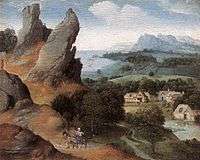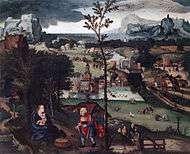Joachim Patinir

Joachim Patinir, also called Patenier (c. 1480 – 5 October 1524), was a Flemish Northern Renaissance history and landscape painter from the area of modern Wallonia.[1] He was probably the uncle of Herri met de Bles, his follower in establishing the world landscape, a distinct style of panoramic northern Renaissance landscapes.[2]
Overview


Originally from Dinant or Bouvignes in present-day Belgium, Wallonia, Patinir became registered as a member of Antwerp's painters’ guild Guild of Saint Luke in 1515, where he spent the rest of his life. He may have studied with Gerard David at Bruges, who had been registered as a guild member in the same year as Patinir. In 1511, Patinir is believed to have travelled to Genoa with David and Adrien Ysenbrandt.
In 1521, Patinir’s friend Albrecht Dürer attended his second wedding and painted his portrait. Dürer called Patinir "der gute Landschaftsmaler" ("a good painter of landscapes"), thus creating a neologism translated later into the French. Patinir often let his landscapes dwarf his figures, which were frequently painted by other artists. Such specialisation had become common in the Low Countries at the time. Many of his works are unusually large for Netherlandish panel paintings of the time, as are those of Hieronymus Bosch, another painter of large landscapes, from a generation earlier.
Patinir's immense vistas combine observation of naturalistic detail with lyrical fantasy, the prime example of which is his The Flight into Egypt (Museum of Antwerp). The rocks in his landscapes are more spectacular versions of those around his native Dinant. The further landscape features are painted with a green and blue palette which expresses the dimming caused by distance. Other examples of his work include The Rest on the Flight into Egypt (Prado, who have four Patinirs, including two signed ones), The Baptism of Christ (one of two in Vienna), St. John at Patmos (by or with his workshop, National Gallery, London), Landscape with the Shepherds (Antwerp), and the Rest on the Flight to Egypt (Minneapolis Institute of Arts). There is also a triptych attributed to him called The Penitence of St. Jerome.[3]
There are only five paintings signed by Patinir, but many other works have been attributed to him or his workshop with varying degrees of probability. The ones that are signed read: (Opus) Joachim D. Patinier, the “D” in his signature signifying Dionantensis (“of Dinant”), which may attest to his provenance from this town. The exhibition at the Madrid Prado Museum contained 21 pictures listed as by Patinir or his workshop, and catalogued a further 8 which were not in the exhibition.[4]
Patinir was a pioneer of landscape as an independent genre and he was the first Flemish painter to regard himself primarily as a landscape painter. Patinir was the friend of not only Dürer, but with Quentin Metsys as well, with whom he often collaborated. The Temptation of St Anthony (Prado) was done in collaboration with Metsys, who added the figures to Patinir's landscape. His career was nearly contemporary with that of the other major pioneer of paintings dominated by landscape, Albrecht Altdorfer, who worked in a very different style.
Patinir died in Antwerp in 1524, and Quentin Metsys became the guardian of his children.
Works
-

Landscape with St Jerome, 1515-1519, oil on panel, 74 x 91 cm (29.1 x 35.8 in), Museo del Prado, Madrid, Spain
-

Landscape with St John the Baptist Preaching, oil on oak, 36.5 x 45 cm (14.1 x 17.1 in), Royal Museums of Fine Arts of Belgium
-

Landscape with The Flight into Egypt, c.1524, oil on panel, 51 x 96 cm (20.1 x 37.8 in), The State Hermitage Museum, Saint Petersburg, Russia
-

Landscape with The Flight into Egypt, oil on panel, 17 x 21 cm (6.7 x 8.3 in), Royal Museum of Fine Arts, Antwerp, Belgium
-

Landscape with the Rest on the Flight (detail), oil on panel, 68 x 83 cm (26.8 x 32.7 in), Strossmayer Gallery of Old Masters, Zagreb, Croatia
-

Rest during the Flight to Egypt, oil on panel, 121 x 177 cm (47.6 x 69.7 in), Museo del Prado, Madrid, Spain
-

St Christopher Bearing the Christ Child, oil on panel, 48 x 59.5 cm (18.9 x 23.4 in), Rockoxhuis, Antwerp, Belgium
-

St Jerome in the Desert, c.1520, oil on panel, 78 x 137 cm (30.7 x 53.9 in), The Louvre Museum, Paris
-

The Penitence of Saint Jerome, c.1512-15, triptych, oil on wood, 117.5 x 81.3 cm (46.5 x 31.9 in), each wing 120.7 x 35.6 cm (47.5 x 14 in), Metropolitan Museum of Art, New York
-
_-_Descanso_en_la_hu%C3%ADda_a_Egipto.jpg)
Rest during the Flight to Egypt (Descanso en la huída a Egipto), oil on panel, 32.5 × 49 cm (12.8 × 19.3 in), Museo Nacional de Bellas Artes (Buenos Aires), Argentina
-

The Rest on The Flight into Egypt, 1515-1524, color on wood, 62 x 78 cm, Gemäldegalerie, Berlin
-

Landscape with the Destruction of Sodom and Gomorrah, c.1520, oil on panel, 22.5 x 308 cm (8.9 x 11.8 in), Museum Boijmans Van Beuningen
-

Crossing the River Styx, oil on panel, 64 × 103 cm (25.2 × 40.6 in), Prado Museum, Madrid
-

Baptism of Christ, oil on oak, 59.5 x 77 cm, Kunsthistorisches Museum, Vienna
See also
Notes
- ↑ (French) Les rochers par lesquels l'art gothique suggère conventionnellement un site sauvage et désertique, sont présents. Comme d'aucuns l'ont remarqué, ces pics rocheux qui vont devenir chez Patinier, indissociables de l'évocation d'un paysage ressemblent à ceux qu'il a pu voir dans la région dinantaise [...] Mais il va de soi que les paysages représentés ne sont jamais dans leur ensemble la transposition de sites existants. L'espace tel que le conçoit Patinier est d'un autre ordre que celui qui s'offre au spectateur dans la réalité.From "L'essor du paysage" in Jacques Stiennon, Jean-Patrick Duchesne, Yves Randaxhe, Cinq siècles de peinture en Wallonie, Les éditeurs d'art associés, Brussels, 1988, p. 67-72.The landscape of the Mosan valley was the inspiration for Patinier, but the result of this inspiration was not a painting of this landscape.
- ↑ Though de Bles was only 14 when Patiner died
- ↑ "List of works in the Prado exhibition, 2007". Museodelprado.es. 2009-09-15. Retrieved 2014-03-19.
- ↑ Prado feature, exhibition "Patinir", 2007, Museo del Prado, Madrid, Spain.
References
- Koch, Robert A. Joachim Patinir (Princeton: Princeton University Press, 1968).
- Battistini, Matilde. Symbols & Allegories in Art: The Hereafter. Los Angeles: The J. Paul Getty Museum, 2005. 210, 212-13.
- Devisscher, Hans. "Patinir, Joachim" Grove Art Online. Oxford University Press, [accessed 6 September 2007].
- Falkenburg, Reindert. Joachim Patinir: Landscape as an Image of the Pilgrimage of Life. Amsterdam/Philadelphia: John Benjamins Publishing Company, 1988.
- Ball-Krückmann, Babette, Landschaft zur Andacht: die Weltlandschaften Joachim Pateniers. Munich 1977 (microfiche)
- Pioch, Nicolas. "The Northern Renaissance (1500-1615)." WebMuseum. 14 October 2002. 28 March 2006.
- Smith Chipps, Jeffery. The Northern Renaissance. Phaidon. Arts & Ideas, 2004. 321.
External links
| Wikimedia Commons has media related to Joachim Patinir. |
- Voigt, Verena, Joachim Patinir (ca. 1485· 1524) and Landscape Painting in the Low Countries Hand (1986): 57. PDF article
- WGA Gallery
- Agence photographique de la réunion des Musées nationaux